
(Photo from The Sun)
Over the past week, you may have read about the discovery of a fish with a rather unsavory taste for a particularly vulnerable part of the human anatomy.
In the rivers and lakes of northern Papua New Guinea, a creature has been attacking people in the water, biting off the (wince) testicles of fishermen. In 2001, 2 men supposedly bled to death after being so unceremoniously castrated. The articles don't state if other people have survived the attacks, but this unseen creature is said to be "like a human in the water, biting at the testicles of fishermen." I'm honestly not sure what this really means though. Does this imply that the animal responsible for the attacks has a bite more like that of a human being, unlike say, the bite of a crocodile, python, turtle, or shark?

(Photo from The Sun)
The hunt for this mysterious nutcruncher forms the premise of an episode of River Monsters, a popular Animal Planet documentary series hosted by biologist and angler Jeremy Wade. I do find it peculiar that while the news about pacu with rather bizarre tastes has only recently spread around the world, the relevant episode was apparently telecast in April 2011.
How's that for some nightmare fuel?
In any case, the culprit is thought to be a red-bellied pacu (Piaractus brachypomus), a fish that hails from the Amazon and Orinoco river basins in tropical South America. It is a large fish, with records of up to 88 centimetres in length, and the heaviest at 25 kilograms. In its native haunts, it bears the name of pirapatinga.

(Photo by Ron's Aquarium Photos)
It has a close relative, often known simply as the pacu (Piaractus mesopotamicus), that is found further south in the Paraguay-Paraná river basin. Slightly smaller than the red-bellied pacu, this species reaches a maximum of 40 centimetres in length, with the heaviest individual ever measured weighing 20 kilograms.
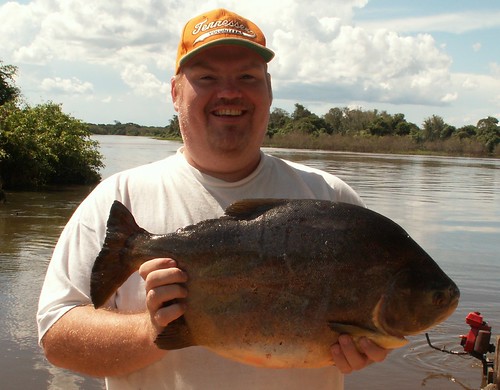
(Photo by West Nashville Gringo)
The name "pacu" however also applies to an even larger relative, a fish also called the tambaqui (Colossoma macropomum), also from the Amazon and Orinoco river basins. This giant reaches a metre in length, and weighs up to 40 kilograms.
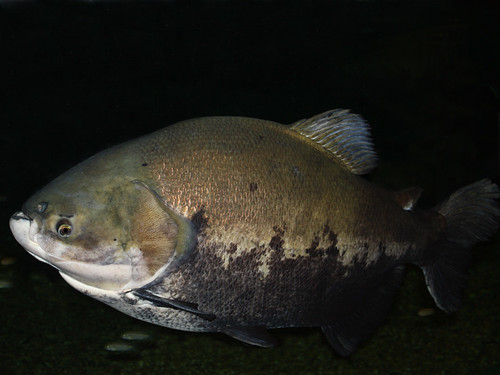
(Photo by Ron's Aquarium Photos)
Despite their newfound reputation, pacu are actually omnivores that specialise on fruits and seeds. In some regions, where large areas of forest are seasonally flooded due to heavy rainfall, these fish (among others) leave the river channels and spread out across the floodplains. Here, fallen fruit and seeds make up an important part of their diet. In fact, studies have revealed that pacu are important seed dispersers in South American forests, potentially transporting seeds over great distances; a palm species in the Pantanal even depends almost entirely on pacu to disperse its seeds.
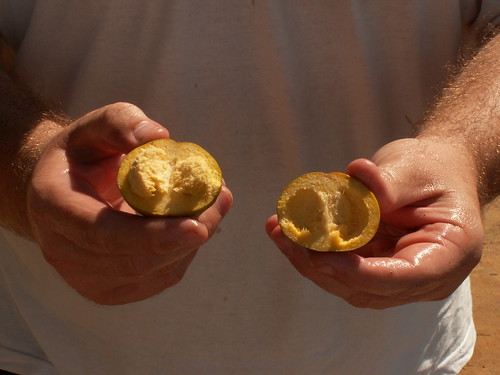
Fruit used as bait when fishing for pacu;
(Photo by West Nashville Gringo)
If you thought the pacu looked a little familiar, that's because they are actually related to the more carnivorous piranhas. Pacus and piranhas together form a family known as the Serrasalmidae, which in some references is still referred to as the subfamily Serrasalminae, under the family Characidae. Whatever the case, yes, your innocuous and harmless little neon tetra (Paracheirodon innesi) is actually a relative of the infamous red-bellied piranha (Pygocentrus nattereri) and the newly notorious nut-cracking pacu.

Neon tetra;
(Photo by balintkafoto)
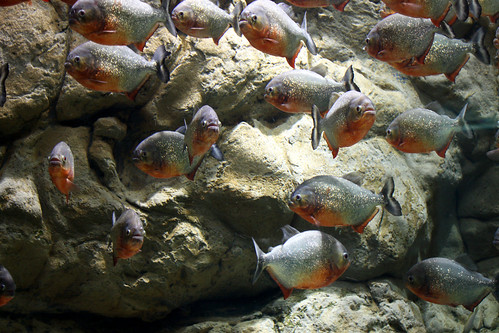
Red-bellied piranha;
(Photo by diwan)
Unlike the piranhas, which have sharp teeth designed for carving out chunks of flesh, the teeth of pacu are adapted for cracking open the hard shells of nuts and seeds. Needless to say, these fishes possess a powerful bite. Despite being mostly vegetarian when adult, pacu will feed on smaller animals such as insects and smaller fish, and as we've seen here, will not hesitate to go after nuts of a different sort.
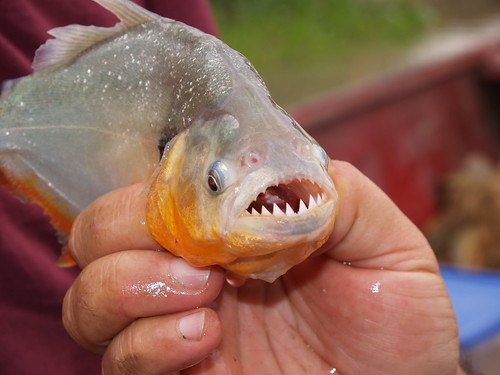
Red-bellied piranha teeth;
(Photo by crocroger)

Tambaqui teeth;
(Photo by Likestofish)
Because of their large size and supposedly tasty flesh, pacu are heavily exploited for food, to the point that there are fears that populations in the wild are being overexploited.

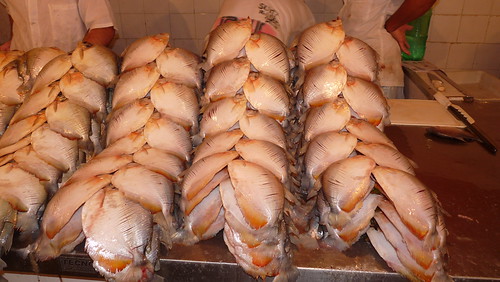
Tambaqui (above) and pacu (below) for sale in Manaus;
(Photos by Marcos Delmar Photostream)
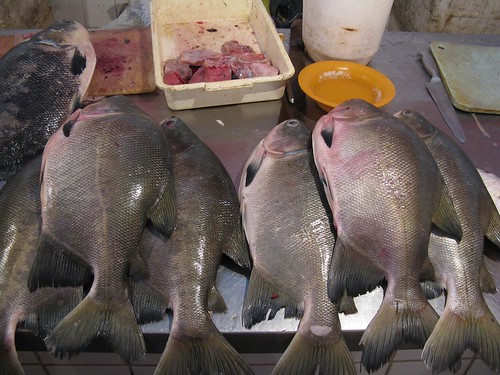
(Photo by Fishwhisperer)
Their desirability as food fish, tolerance of a range of water conditions, and ability to grow rapidly, have made all three species of pacu prime candidates for aquaculture and fisheries. Pacu are very strong fighters when hooked, and so they have become popular with sport fishermen. As a result, populations of the various species of pacu can now be found in many parts of the Caribbean, Southeast Asia, China, Taiwan, and Hong Kong. In the case of the pacu in the Sepik and Ramu rivers in Papua New Guinea, these were deliberately released along with several other fish species as part of a United Nations Food and Agriculture Organisation project to improve fisheries in these areas.

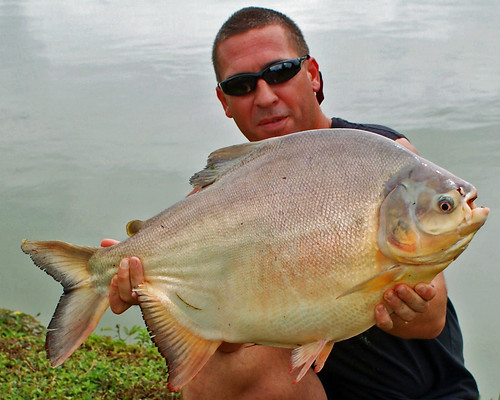
Tambaqui (above) and pacu (below) caught in Thailand;
(Photos by Dave 2x)
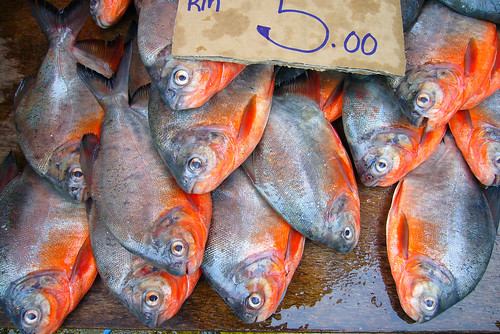
Pacu for sale in Kuching market, Malaysia;
(Photo by Eric Hunt)
Young pacu are quite commonly encountered in the pet trade, and many unsuspecting novices purchase them without carrying out proper research, only to find out that the little juveniles don't stay small for very long. There are many reports of pacu being caught in North American rivers and lakes, presumably dumped by irresponsible owners who could not afford to provide the care and space required for such large fishes. Because of their close resemblance to piranhas, such discoveries of pacu in foreign lands inevitably create some panic, especially since juvenile pacu do actually look a lot like piranha.
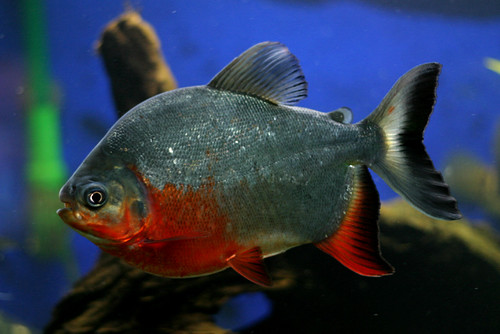
Juvenile red-bellied pacu;
(Photo by andripogo)

Red-bellied piranha;
(Photo by g-na)
Presumably, most of these newly liberated pacu will die when the cold of winter sets in, but in warmer climates like that of Florida, there is always the possibility that pacu will eventually establish breeding populations.
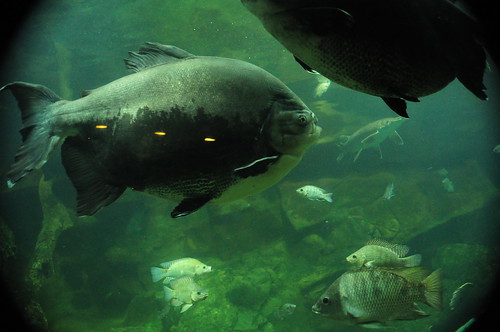
Pacu at Underwater World Singapore;
(Photo by Kathryn Goering)
In Singapore, I have seen pacu being featured in exhibits in the Singapore Zoo and Underwater World Singapore, in some ornamental ponds alongside koi, as well as on a few fish farms. I do recall seeing young pacu being offered for sale in pet shops, although I have not had any recent encounters. There are also fishing ponds catering to anglers that are stocked with pacu (among other exotic species). In any case, pacu have somehow managed to enter our reservoirs, with red-bellied pacu being recorded at Jurong Lake and MacRitchie Reservoir, and an unverified sighting of a "piranha" at Lower Seletar is likely to be another pacu. These are most probably discarded pets, dumped by owners after outgrowing their tanks, although there is also the possibility that an angler, wanting the thrill of pitting their skills against a pacu without having to travel to South America, may have released pacu into our reservoirs. It's rumoured that this is how peacock bass (Cichla spp.), another South American fish that is a prized sport fishing target, first entered our reservoirs. As far as I know, unlike tilapia (Oreochromis spp.), pacu have failed to become established as a food fish here, and are raised mostly for the aquarium trade.
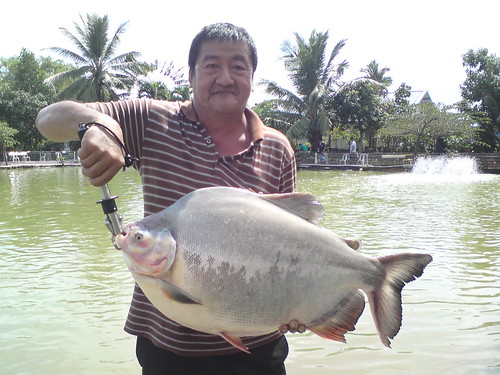
Pacu caught at fishing pond, Pasir Ris;
(Photo by farmway3)
Whether pacu have any negative impact on freshwater ecosystems in Singapore is unknown, but at the moment, it appears that like many other non-native fish species, they are largely restricted to the open waters of our reservoirs, and have yet to invade our forest streams, the last refuge for many of our native aquatic species. There are already a number of large and potentially dangerous exotic fish in our waters, and while the pacu is usually thought to be a peaceful vegetarian, its suspected testicle-chomping tendencies really cast it in a new sinister light. I'm sure it goes without saying that if you're male, going skinny-dipping in the reservoir is not a good idea at all, unless you want to run the risk of never being able to reproduce ever again.